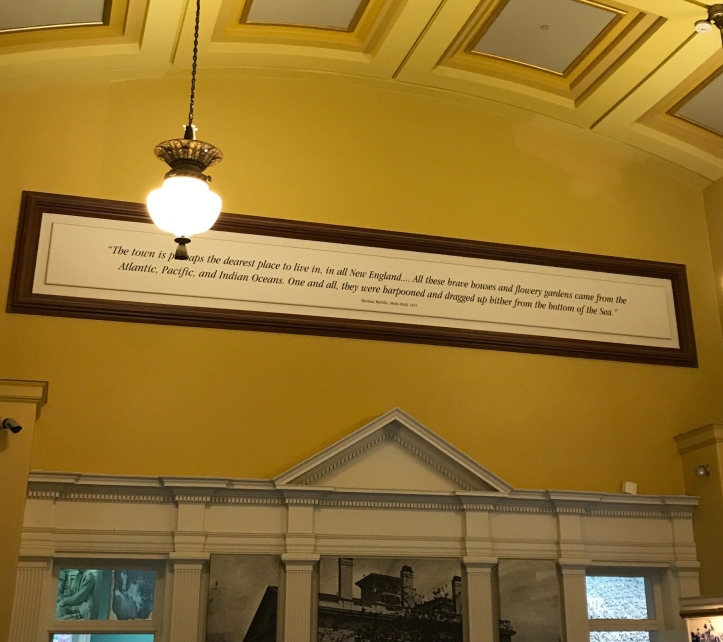As you might have read in a previous post, my book club at the Boston Athenæum is reading Moby-Dick. Before our first meeting, the group decided to take a field trip down to New Bedford, to visit the Whaling Museum and get a sense of whaling and Melville and all the things. Here’s a recap!
“The Grand Panorama of a Whaling Voyage ‘Round the World”

Back in the 19th century, before movies and TV and scrolling through our phones, there was literal scrolling – in the form of panoramas. These were massive paintings that were fitted to a giant roller, displayed in large theaters called cycloramas (Boston has one in the South End), and showed a panorama of cities, battles, scenes, etc. Painted in 1848 by Caleb Purrington and Benjamin Russell, who sailed the world during the high-time of whaling, this panorama is 1,275 feet long (uh, longer than the Empire State Building is high), and all of it is on display in New Bedford.

The panorama was a sight to see once (fantastically marketed as “3 miles of canvas!”), but fell into disrepair from its travels, and went missing for a while. In 1918, the New Bedford Whaling Museum acquired it (after it was found in the attic of a warehouse), but didn’t really do much with it until the 1950s, when a conservation effort was spearheaded. The work was finally completed last year, and the panorama is now on display through October 8. It was the first stop on our voyage.
There are four sections total (you see one section running the length of the mill building above, so you can imagine the length of four of them!), and the journey of the panorama takes you from New Bedford (seen in the picture just above), out into the sea, to the South Pacific, around the Horn, to Hawai’i, to the coast of South America, and more. As you can see, there is incredible detail, and the landscapes are recreated with exactness. Many famous ships or scenes from maritime history are recreated as well, including the mutiny on the Bounty and the sinking of the Essex. What an absolutely marvelous, priceless thing to see! Find out more here.

 Tia Maria’s for Lunch
Tia Maria’s for Lunch
Because there is a deep Portuguese history in whaling, and maritime endeavors in general, we went to have lunch at Tia Maria’s European Café, which is behind the Whaling Museum. I’m on a chorizo kick right now (which I found out is spelled chouriço in Portuguese, and pronounced “shore-EE-so”), so I got the chouriço sandwich on a Portuguese roll, with rodelas, or thick potato chips. Fantastic! We returned later for a snack before heading back up to Boston, and I got some chocolate mousse and a galão coffee. I usually stop here during the Moby-Dick Marathon, so was excited to do so again. (“I’m here from the Marathon!! See my shirt??” “Ah. Thanks for the warning…”)

The Seaman’s Bethel
In Chapter 7 of Moby-Dick, Ishmael visits a chapel in New Bedford, the Seaman’s Bethel, to listen to Father Mapple preached a sermon on Jonah. Each year during the Moby-Dick Marathon, we read the first few chapters in the Whaling Museum, and then head across the street to the Bethel, where the sermon in the novel is read aloud/preached by a local minister. We also sing the hymn, “The Ribs and Terrors In the Whale” (with, of course, lyric sheets, and music from an organist). The walls of the Bethel are marked with marble memorials to sailors and whalers lost at sea, and Melville creates his own in the novel. Above, you’ll see the pulpit of the chapel looking like the bow of a ship, and this was built in order to simulate the description in the novel (well…). But, the chapter in the novel was based on this real chapel, still here back in the 1800s, and I found Herman Melville’s pew in the back.
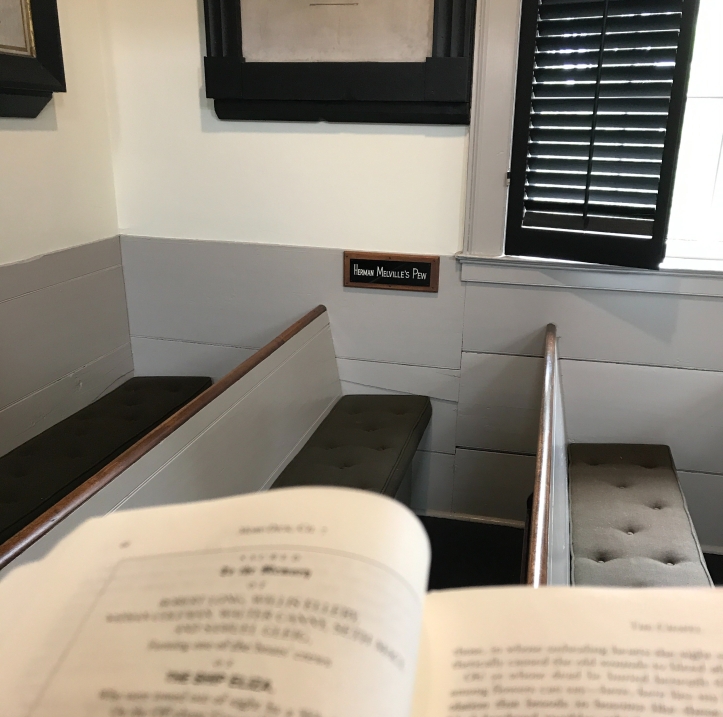
New Bedford Whaling Museum
Finally, we had arrived to the New Bedford Whaling Museum, possibly one of the most extensive whaling museums around (Nantucket’s, of course, is great, too, and Mystic has a smaller yet substantial one, but New Bedford was the hub of whaling in the 19th century, and called “The City that Lit the World”). In addition to the main rooms dedicated to whaling, you’ll find yourself getting lost in all the little galleries showing various photo exhibitions, a replica 19th century room, industry in New Bedford, the Herman Melville Room (see below), an exhibit on knots, the vast scrimshaw room, an exhibit on King Philip’s War, a wall about religion in the Colonies, a digital scrolling representation of the panorama we saw, and more and more and more. I’ve been to the Moby-Dick Marathon here three times now, and you get the chance to run around the museum (and stay here all night), so I’ve seen much of the exhibits. But I did get the chance to pay more attention to the contents.
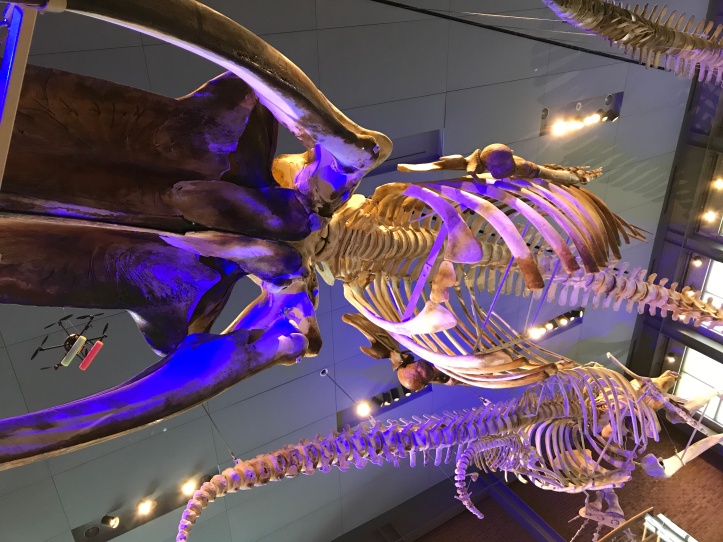

You’re greeted with whale skeletons when you enter the main level, and the first time I came to the Marathon, I slept in the balcony with this guy staring me in the face, so I have fond memories. He (she?) still leaks oil from its bones, and the oil is collected into a beaker. Additionally, to give you some scale, the have a whale heart model, and you can literally hide in the chamber. One of our book club members said that with the scale, you can actually imagine Jonah hanging out inside of a whale for three days.
Upstairs are the main whaling galleries, with whaling artifacts from both native populations and the American whaling industry of the 19th century: harpoons, ship gear, examples of what oil would have been used for and in back in the 19th century. One of the more striking focii of the room is the massive whale skeleton (we used to come into this room to read the chapter “Cetology” in Moby-Dick during the Marathon, when there were few of us to fit), with a whaleboat next to it. It gives you a sense of what these men were doing by going out into that boat, to try to throw harpoons at the massive creatures in the water, in calm or choppy seas, sun or rain.
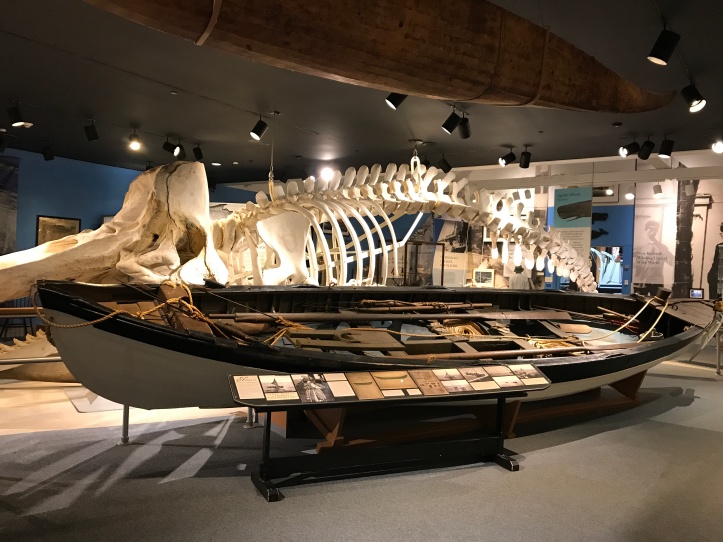
Here are some words from Ishmael, on his first time in a whaleboat: “It was a sight full of quick wonder and awe! The vast swells of the omnipotent sea; the surging, hollow roar they made, as they rolled along the eight gunwales, like gigantic bowls in a boundless bowling-green; the brief suspended agony of the boat, as it would tip for an instant on the knife-like edge of the sharper waves, that almost seemed threatening to cut it in two; the sudden profound dip into the watery glens and hollows; the keen spurrings and goadings to gain the top of the opposite hill; the headlong, sled-like slide down its other side;—all these, with the cries of the headsmen and harpooneers, and the shuddering gasps of the oarsmen, with the wondrous sight of the ivory Pequod bearing down upon her boats with outstretched sails, like a wild hen after her screaming brood;—all this was thrilling.”
The Lagoda
In the massive main room of the museum, where the process of whaling is explained, where you can see the tools on board, and even sniff some pre- and post-rendered oil, sits the Lagoda, the largest model ship in the world, a 89 foot half-scale model. I’ve been around it before, but I hadn’t gone on it until that day, and looking around, it reminded me of the Charles W. Morgan, the last remaining whaling ship, currently docked in Mystic, CT. It reminded me of the tight quarters and close spaces of a whaleship, living and going about life while having essentially an entire factory on board. This is the room (and the view) where the Marathon begins.

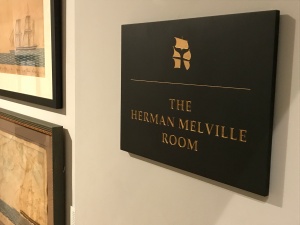
The Melville Room
One of the newest addition to the Museum is The Herman Melville Room, dedicated, I believe, only a few years ago. Contrary to what you’d think, it doesn’t contain items on Herman Melville, but rather a collection of whaling logs. That absolutely fascinates me, because the logs not only contain the basic data on whaling (which has helped contemporary scientists track whale populations, climate change, and more), but they contain illustrations. You can see some of the selections below.
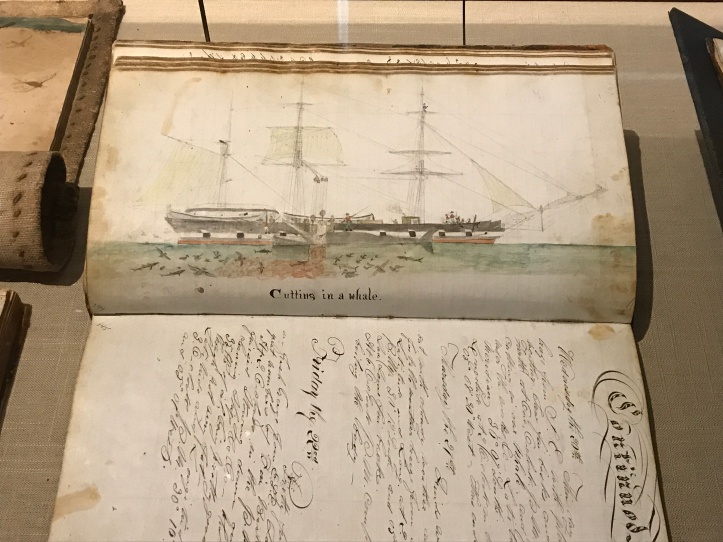


Imagine the mate on board vessels that were a whole floating factory, crew members venturing out into small whaleboats trying to kill these mammoth creatures vastly bigger than the whaleboat, then lashing the whale to the side of the ship, stripping it of its blubber, and then firing up giant flaming cauldrons to render the blubber. And the mate is drawing, creatively interpreting what’s going on around him. It’s such a clash, such dirty work versus such delicacy.
Heading Back
Melville died penniless (honestly, he was penniless most of his life), and unknown. He wrote a novel that was fifty years ahead of its time stylistically, a novel nobody cared about back then, that was mis-shelved for years. A novel that, now, nearly everyone has heard of, a novel that New Bedford circles a lot of its tourism around. A novel that is even quoted in town’s visitor’s center (below). If you’ve had the chance to read my post “A Cup of Coffee with Melville,” you’ll know how deeply I think about this: I wish he knew. I wish I had a time machine, and could go back, and just say, “Look, we’re going to get it. Eventually, we’re going to understand. We’re going to have reading marathons of your novel, and thousands of people are going to stop in for it. We’re going to put your quotes on walls. We’re going to put a plaque where your pew was. Just wait. It’ll happen.”
